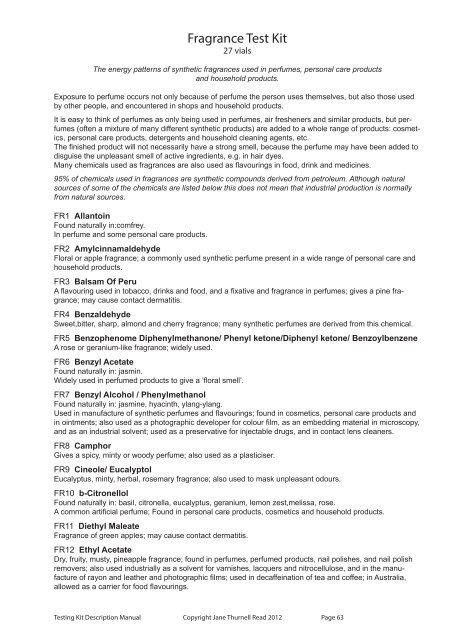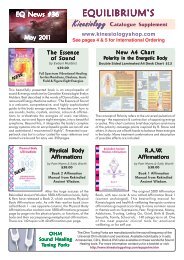Create successful ePaper yourself
Turn your PDF publications into a flip-book with our unique Google optimized e-Paper software.
Fragrance Test Kit<br />
27 vials<br />
The energy patterns of synthetic fragrances used in perfumes, personal care products<br />
and household products.<br />
Exposure to perfume occurs not only because of perfume the person uses themselves, but also those used<br />
by other people, and encountered in shops and household products.<br />
It is easy to think of perfumes as only being used in perfumes, air fresheners and similar products, but perfumes<br />
(often a mixture of many different synthetic products) are added to a whole range of products: cosmetics,<br />
personal care products, detergents and household cleaning agents, etc.<br />
The finished product will not necessarily have a strong smell, because the perfume may have been added to<br />
disguise the unpleasant smell of active ingredients, e.g. in hair dyes.<br />
Many chemicals used as fragrances are also used as flavourings in food, drink and medicines.<br />
95% of chemicals used in fragrances are synthetic compounds derived from petroleum. Although natural<br />
sources of some of the chemicals are listed below this does not mean that industrial production is normally<br />
from natural sources.<br />
FR1 Allantoin<br />
Found naturally in:comfrey.<br />
In perfume and some personal care products.<br />
FR2 Amylcinnamaldehyde<br />
Floral or apple fragrance; a commonly used synthetic perfume present in a wide range of personal care and<br />
household products.<br />
FR3 Balsam Of Peru<br />
A flavouring used in tobacco, drinks and food, and a fixative and fragrance in perfumes; gives a pine fragrance;<br />
may cause contact dermatitis.<br />
FR4 Benzaldehyde<br />
Sweet,bitter, sharp, almond and cherry fragrance; many synthetic perfumes are derived from this chemical.<br />
FR5 Benzophenome Diphenylmethanone/ Phenyl ketone/Diphenyl ketone/ Benzoylbenzene<br />
A rose or geranium-like fragrance; widely used.<br />
FR6 Benzyl Acetate<br />
Found naturally in: jasmin.<br />
Widely used in perfumed products to give a ‘floral smell’.<br />
FR7 Benzyl Alcohol / Phenylmethanol<br />
Found naturally in: jasmine, hyacinth, ylang-ylang.<br />
Used in manufacture of synthetic perfumes and flavourings; found in cosmetics, personal care products and<br />
in ointments; also used as a photographic developer for colour film, as an embedding material in microscopy,<br />
and as an industrial solvent; used as a preservative for injectable drugs, and in contact lens cleaners.<br />
FR8 Camphor<br />
Gives a spicy, minty or woody perfume; also used as a plasticiser.<br />
FR9 Cineole/ Eucalyptol<br />
Eucalyptus, minty, herbal, rosemary fragrance; also used to mask unpleasant odours.<br />
FR10 b-Citronellol<br />
Found naturally in: basil, citronella, eucalyptus, geranium, lemon zest,melissa, rose.<br />
A common artificial perfume; Found in personal care products, cosmetics and household products.<br />
FR11 Diethyl Maleate<br />
Fragrance of green apples; may cause contact dermatitis.<br />
FR12 Ethyl Acetate<br />
Dry, fruity, musty, pineapple fragrance; found in perfumes, perfumed products, nail polishes, and nail polish<br />
removers; also used industrially as a solvent for varnishes, lacquers and nitrocellulose, and in the manufacture<br />
of rayon and leather and photographic films; used in decaffeination of tea and coffee; in Australia,<br />
allowed as a carrier for food flavourings.<br />
Testing Kit Description Manual Copyright Jane Thurnell Read 2012 Page 63



